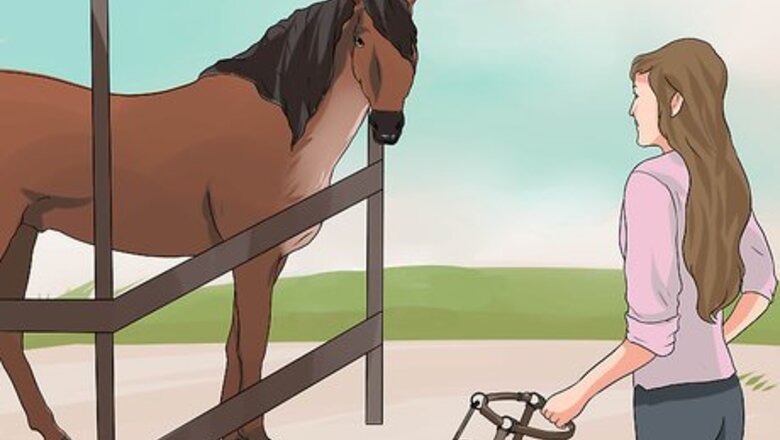
views
Getting the Bridle in Place
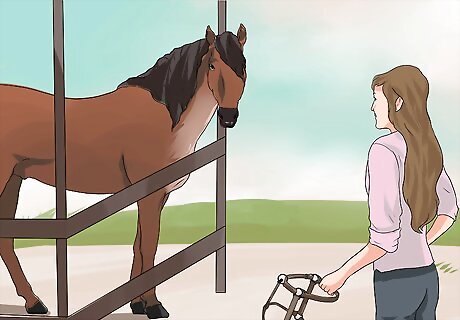
Have the bridle ready. The bridle should be draped over your non-dominant arm, ready to be put on the horse. The bridle holds the bit in place. The bridle includes the reins, which is what you use to guide the horse, by pulling on them to move the bit. Depending on the type of bridle you have, you may need to unbuckle the nose strap to make it easier. You'll need to unbuckle English bridles, for instance.
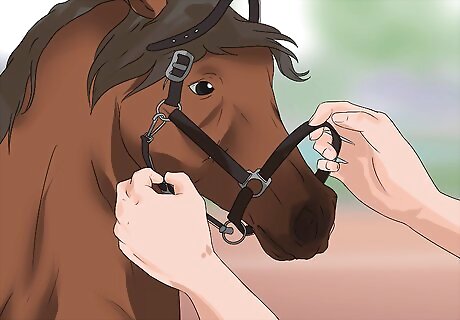
Take off the halter. The first part of a bridling a horse is taking its halter off. The halter is what fits over the horse's face so you can lead it around when you are not riding it. You usually take it off to ride, though some people do apply a bit and bridle over the halter. Unbuckle the strap, and pull the halter down off the horse's face. If your horse is accustomed to being bridled, you can take the halter completely off. If it's not, you should buckle just the strap around the horse's neck. That way, you can hold on to the horse if it tries to move away.
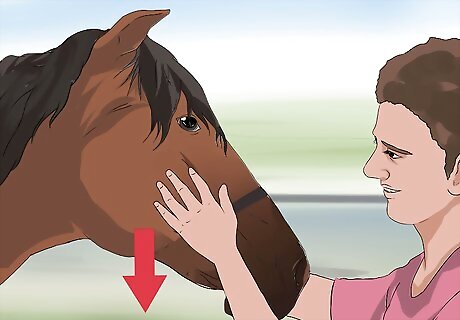
Bring the horse's head down. To put the bridle on, you'll need to bring the horse's head down. To bring its head down, use your hand between its ears to guide its head lower. You also want to move its head towards you if possible. Sometimes, the horse will need some convincing or will seem nervous. Don't try to shove its head down. Rather, keep gentle pressure on its head until it relaxes its head and moves it down.
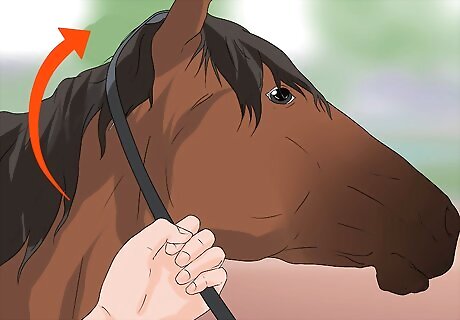
Drape the reins over the horse. Make sure the bridle is going the right direction, facing outward. When it's facing the correct way, put the reins over the horse to get them out of the way. Draping them is easier than having them drag on the ground.

Change hands with the bridle. Now, put the bridle in your dominant hand. Your dominant arm should be next to the horse, and you should be facing the same direction the horse is, except maybe turned slightly towards the horse. The top piece (crown) should be in your dominant hand, so you can pull it over the horse's head.
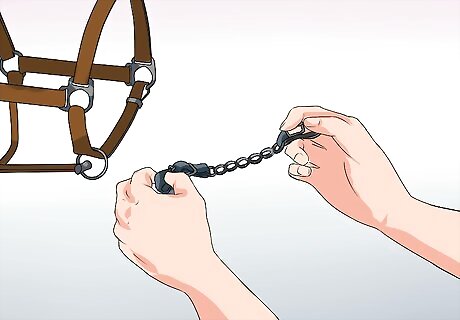
Separate the curb chain. As you pull the crown up the horse's head, make sure the curb chain or strap is separate from the bit. Only certain types of bridles have curb chains, so yours may not have one. The curb chain goes under the horse's chin, which is why you need to separate it from the bit. Don't bang the horse's teeth with the curb strap.
Inserting the Bit and Securing the Bridle

Ask the horse to open its mouth. No, you don't ask the horse with words. You tell the horse you want it to open its mouth by inserting your thumb into its mouth, behind the teeth. The teeth sit to the front of the horse's mouth, leaving a space behind them for the bit. Basically, you want to aim for the back edge of the mouth, along the side of the horse's head. Use your non-dominant hand to stick a thumb in the horse's mouth, as you're holding the crown with your dominant hand. If the horse seems reluctant, try moving your thumb around. Lightly touch the horse's gums. Doing so will tell the horse it needs to open its mouth.
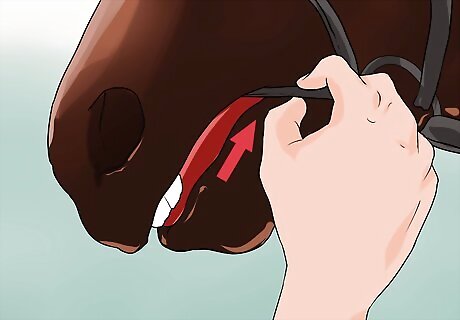
Put the bit in. Once the horse's mouth is open, slide the bit in. As you do, make sure you guide the bit between the horse's teeth. Be careful of the horse's teeth. Try not to touch them at all with the bit. Keep moving it gently back until the bit is in the back of the horse's mouth. At the same time, pull the crown of the bridle up over the horse's head, sliding the bit into place. The pressure should come from the crown moving up, not you pushing the bit with your left hand. If the bridle has a curb strap, be sure to guide that with your left hand, too. The bit goes over the horse's tongue, not under it. There should be about 2-3 wrinkles at the corners of the horse's mouth when the bit is sitting properly. If the horse looks like it's smiling, the bit is too high. Don't let the bit hang too low either. If the bit isn't right, it could hurt the horse.
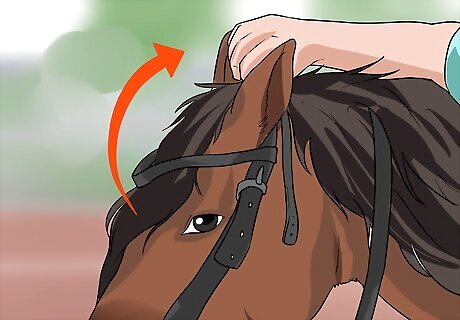
Pull the crown over the ears. Make sure to move the ears forward first. Don't smash them down, just use your hand to move them one at a time. As you do, pull the crown over each side until the bridle is in place to complete putting the bridle on. Some bridles have a brow band that stays across the forehead. Others have loops that go over the horse's ears.
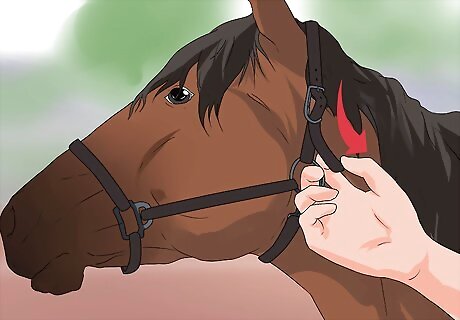
Fasten the buckles. Fasten the buckle around the neck, called the throatlatch. Make sure you can put about four fingers underneath it. After that, buckle the chin strap, leaving two fingers worth of space underneath it. In addition, you may need to buckle the curb strap. If you have an English bridle, you'll need to buckle the nose piece into place.
Taking the Bit Out
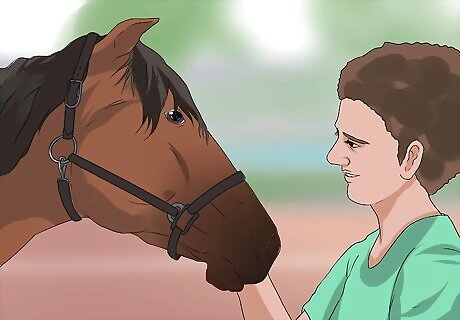
Place the halter around the horse's neck. Once again, you'll use the halter to keep hold of the horse by strapping the halter around it's neck. Right now, it's not completely on. You're just using it as a way to steady the horse as you take the bridle off.
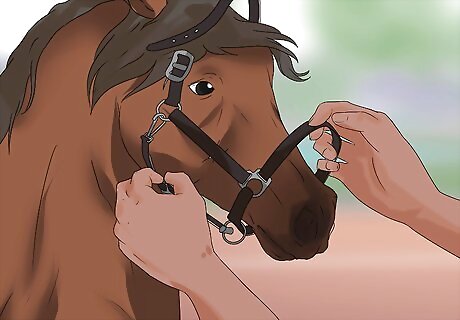
Unbuckle the straps. Now, do all the straps in reverse. Unbuckle the chin strap and the curb strap, if the bridle has one. Unbuckle the nose piece, if the bridle has one. Also, undo the throatlatch. In other words, make sure all the buckles are undone in anticipation of pulling the bridle off.
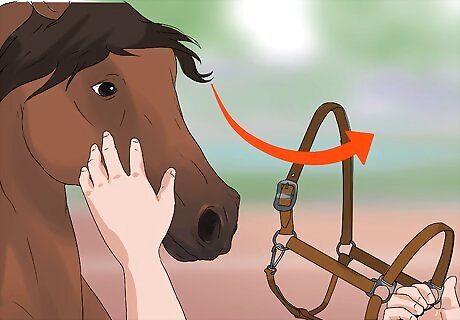
Pull the bridle off. Using your dominant hand, take hold of the crown, and pull it over the horse's ears. Try not to smash the horse's ears as you pull it off. The horse should naturally release the bit, but as you pull the bridle off, use your non-dominant hand to guide the bit through the horse's teeth.
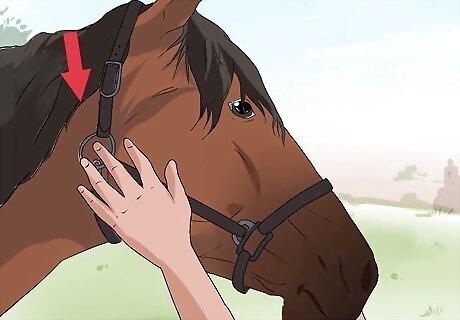
Put the halter on. Once you've pulled the bridle off and away, unbuckle the halter from the neck. The halter goes on much like the bridle, except without the bit. Instead, you just have the headstall instead of the crown and a nose band instead of a bit. Slide the headstall over the horse's head as you pull the nose band over the horse's nose, making sure you don't smash the horse's ears or poke the horse in the eye. Buckle or clip the throatlatch into place around the horse's head. The lead line should be attached to the halter, so you can lead the horse back to the stall or wherever you want it to go.
Solving Bit Problems

Check the horse for medical problems. If the horse doesn't want to take the bit or it seems uncomfortable with the bit, you should have the horse checked by a vet. Problems with the mouth, tongue, or teeth, including ulcers, can lead to problems with the bit because they will make the bit uncomfortable for the horse. If the vet doesn't find anything, try a horse dentist instead.
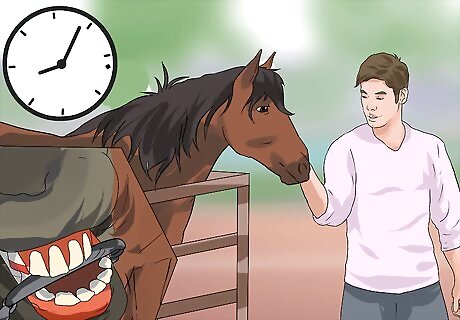
Train the horse to stop chewing on bits. If your horse is always chewing on the bit, it can cause problems with the bridle set up, stretching out the leather, among other issues. One way you can help your horse is to slowly train it to become used to the bit without chewing by letting the horse wear it for a certain period each day. Start by putting the bit and bridle on the horse while its in its stall, making sure you don't use one that can catch on things in the stall. Also, take off the reins and nose band before putting it on. Stay with the horse will it has the bridle on. Leave it on for about an hour. Keep doing this training everyday until the horse seems comfortable and doesn't chew anymore. Next, try it on the longe line with a halter over the bridle. Work with the horse a little everyday until it seems comfortable without chewing the bit. After that, you can try riding the horse.
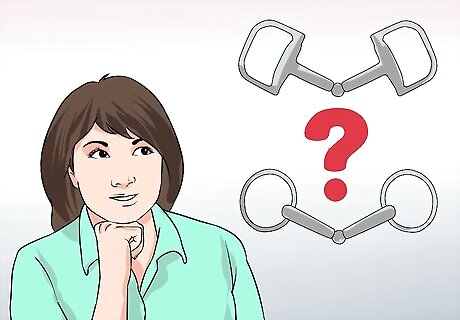
Try a different bit if your horse seems uncomfortable. Some horses don't like certain bits, and they won't respond how you'd like to your rein movement. Bits put pressure on the tongue, so sometimes a bit that doesn't put as much pressure on the tongue can be helpful if your horse is sensitive. For instance, some curve across the tongue instead of going straight across. See if anyone you know has bits you can borrow to try on your horse. That way, you can see which one works the best. A different bit can also help retrain your horse not to put its tongue over the bit if it has picked up that habit.
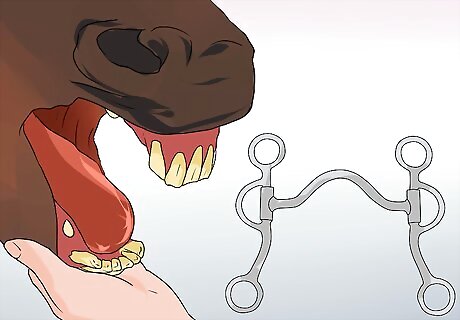
Try a tongue port for tongue problems. If your horse keeps putting its tongue over the bit and you've tried other options, you can add a tongue port. It fits over the bit, and a rubber part hangs down. The rubber bit makes it harder for your horse to move its tongue over the bit.












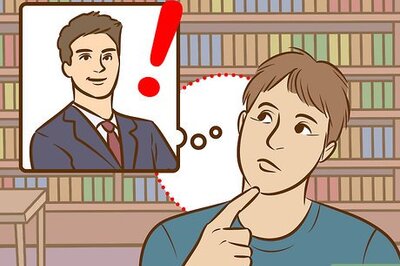
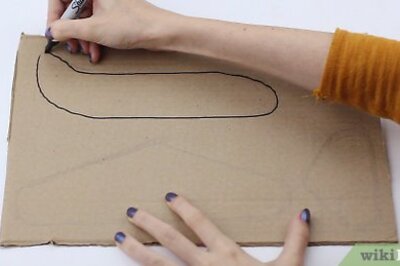





Comments
0 comment